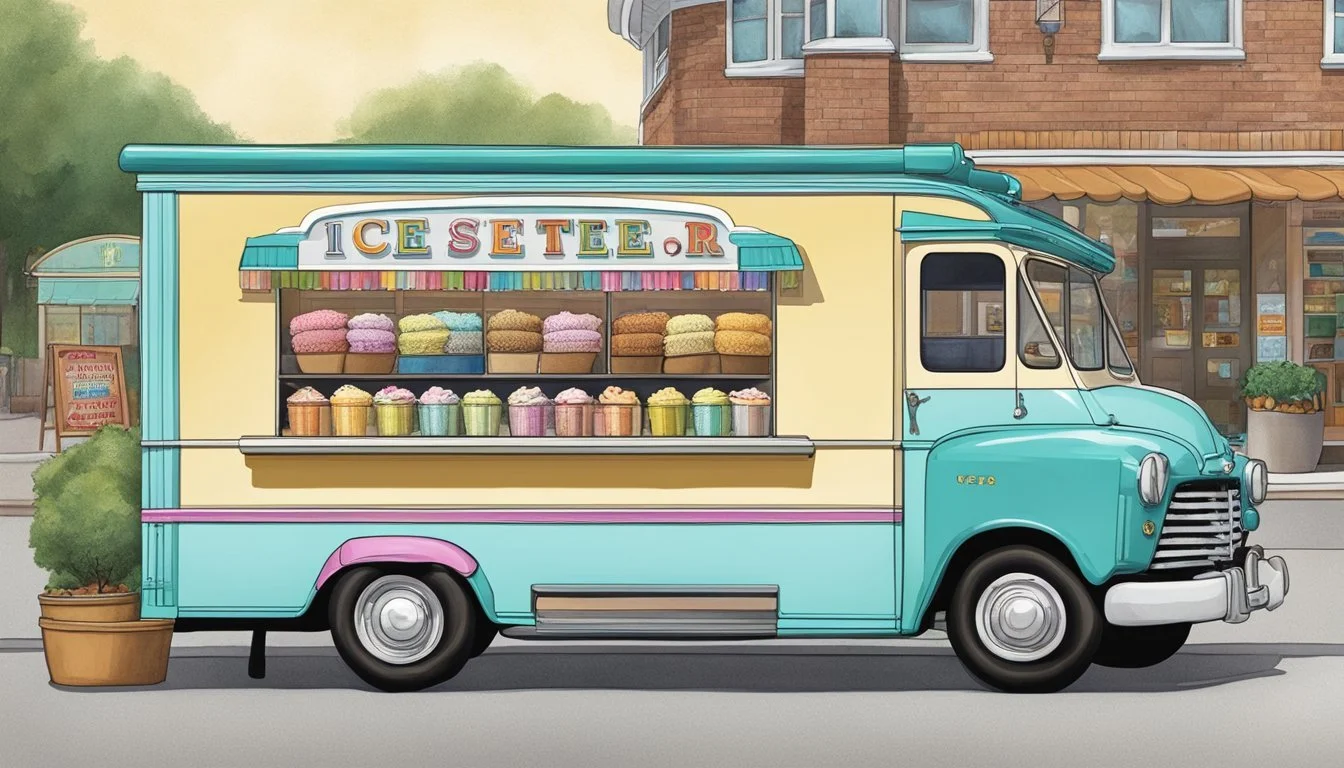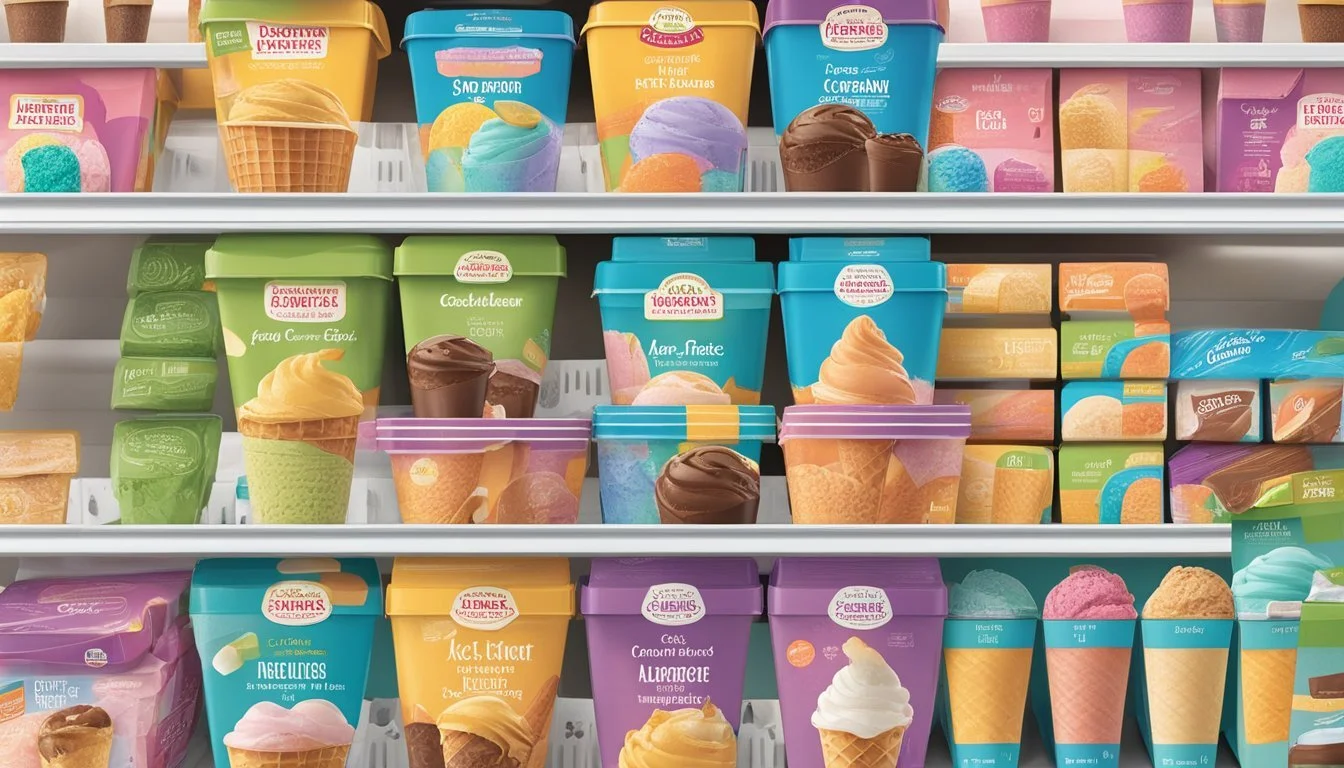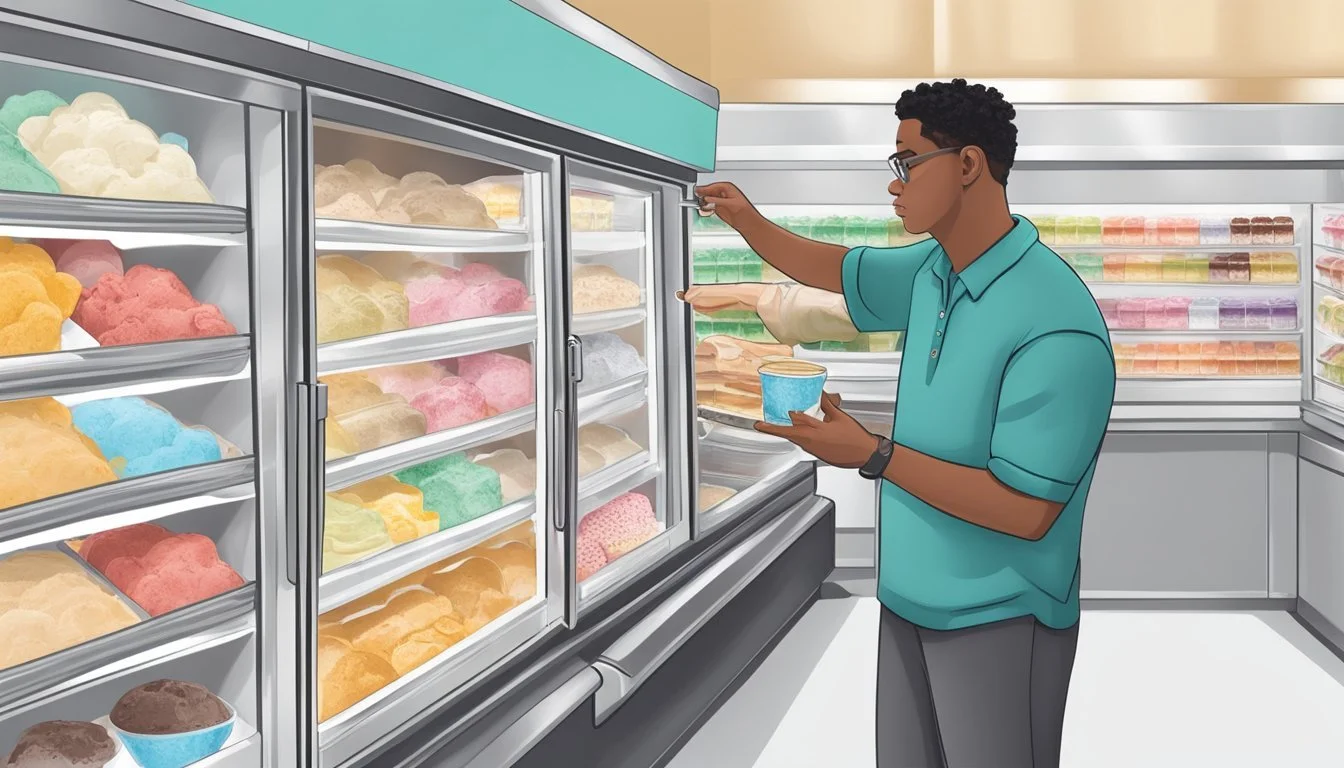Indulge in Harris Teeter's Premium Ice Cream Selection
A Comprehensive Guide to Flavors and Quality
Harris Teeter offers a delightful array of ice cream options to satisfy any sweet tooth. From classic flavors to unique creations, their frozen treats cater to diverse tastes and preferences. Harris Teeter's ice cream selection includes their own brand as well as popular national brands, providing customers with quality and variety at competitive prices.
The grocery chain's ice cream aisle features a wide range of flavors, from traditional vanilla and chocolate to more adventurous options. Harris Teeter's store brand ice cream comes in various sizes, including pints and half-gallons, making it easy for shoppers to find the perfect portion for their needs.
Customers can conveniently purchase Harris Teeter ice cream through multiple channels. The products are available in-store, online for pickup or delivery, and through third-party delivery services like Instacart. This flexibility allows ice cream lovers to enjoy their favorite frozen desserts with ease.
History of Harris Teeter Ice Cream
Harris Teeter's journey into ice cream production began in 1980 with a strategic acquisition. This move allowed the company to expand its dairy offerings and develop a popular ice cream range.
Founding of Harris Teeter
Harris Teeter's roots trace back to 1936 when W.T. Harris opened his first grocery store in Charlotte, North Carolina. The company grew steadily over the decades, merging with Teeter's Food Marts in 1960 to become Harris Teeter.
In 1980, Harris Teeter made a significant decision that would shape its future in the ice cream market. The company purchased Hunter Farms dairy in High Point, North Carolina. This acquisition marked Harris Teeter's entry into dairy production.
Development of Ice Cream Range
The Hunter Farms acquisition enabled Harris Teeter to produce its own milk, ice cream, and other dairy products. This vertical integration allowed the company to reduce costs and maintain quality control over its dairy offerings.
In 1990, Harris Teeter doubled its ice cream production capacity by purchasing the Borden High Point plant. This expansion solidified the company's position in the ice cream market.
Harris Teeter's private label ice cream, HT Traders, became a fan favorite. The brand offers a variety of flavors, continuing the legacy of William Thomas's dairy farm from the 1940s.
Today, Harris Teeter's ice cream range includes both its private label products and national brands. The company's frozen foods department features a wide selection of ice cream products, from traditional flavors to premium options.
Understanding Ice Cream Varieties
Ice cream comes in a wide array of styles and flavors. The quality and taste can vary significantly based on production methods and ingredients used.
Artisanal vs. Commercial Ice Cream
Artisanal ice cream is typically made in small batches with high-quality ingredients. It often features unique flavor combinations and locally-sourced components. These premium products generally have a lower overrun, resulting in a denser, creamier texture.
Commercial ice cream, on the other hand, is mass-produced for wide distribution. It usually contains more air and stabilizers to maintain consistency during transport and storage. This type of ice cream is more readily available and often less expensive than artisanal options.
Many supermarket chains, like Harris Teeter, offer both commercial and artisanal-style ice creams to cater to different consumer preferences and price points.
The Significance of Ingredients
The ingredients in ice cream play a crucial role in its flavor, texture, and overall quality. High-fat cream and fresh milk form the base of premium ice creams, contributing to a rich mouthfeel.
Sugar not only sweetens but also affects freezing point and texture. Natural flavorings like vanilla beans or fruit purees enhance taste profiles. Some brands use artificial flavors and colors to reduce costs or create unique varieties.
Stabilizers and emulsifiers are common in commercial ice creams. They help maintain consistency and prevent ice crystal formation. However, artisanal producers often minimize these additives, focusing on natural ingredients for a purer taste experience.
Brands and Flavors at Harris Teeter
Harris Teeter offers a diverse selection of ice cream brands and flavors to satisfy various preferences. From their own private label options to popular national brands, customers can find a wide range of choices in their frozen foods department.
Private Label Brands
Harris Teeter's private label ice cream brands include Harris Teeter Premium Selections and Harris Teeter. These house brands offer quality products at competitive prices.
Harris Teeter Premium Selections features flavors like Moose Tracks and Chocolate. The Moose Tracks variety combines vanilla ice cream with peanut butter cups and fudge swirls.
Harris Teeter's regular line also provides affordable options. Both private label brands come in 48 fl oz tubs, making them suitable for families or ice cream enthusiasts.
Popular Ice Cream Brands
In addition to their private labels, Harris Teeter stocks well-known national ice cream brands.
Blue Bell is a prominent brand available at Harris Teeter. They offer assorted flavors in their Gold Rim tubs.
Other popular brands found in Harris Teeter's freezer section include:
Private Selection
AriZona
Amoretti
These brands provide unique flavors and textures. For example, Private Selection offers a Sea Salt Caramel Truffle flavor for those seeking indulgent options.
Harris Teeter's ice cream selection includes pints and larger tubs to cater to different serving needs. Customers can find over 900 ice cream products in-store or through online ordering for pickup and delivery.
Nutritional Content and Labeling
Harris Teeter ice cream provides detailed nutritional information on its packaging to help consumers make informed choices. This includes calorie counts, macronutrient breakdowns, and ingredient lists.
Understanding Nutritional Information
Harris Teeter vanilla ice cream contains approximately 140-150 calories per 1/2 cup (67g) serving. The macronutrient profile shows about 51% of calories from fat, 43% from carbohydrates, and 6% from protein. A typical serving provides around 7-8 grams of fat, 15-16 grams of carbs, and 2-3 grams of protein.
Some varieties, like Harris Teeter's churned ice cream, may have a lower calorie count of around 110 calories per serving. The nutritional content can vary between flavors and product lines.
Harris Teeter also includes vitamin and mineral information on their labels. This helps consumers track their intake of nutrients like calcium, which is naturally present in dairy-based ice creams.
Labeling Standards
Harris Teeter follows FDA guidelines for food labeling on their ice cream products. Nutrition facts are clearly displayed in a standardized format, making it easy for consumers to compare different products.
The ingredient list is provided in descending order by weight. For their vanilla ice cream, common ingredients include milk, cream, sugar, and natural flavors.
Allergen information is prominently featured, as ice cream often contains common allergens like milk. Harris Teeter also includes statements about potential cross-contamination risks for those with severe allergies.
Serving sizes are standardized for ice cream products, typically listed as 1/2 cup or 67 grams. This allows for consistent comparisons between different brands and flavors.
Harris Teeter's Ice Cream Marketing and Promotions
Harris Teeter employs targeted marketing strategies and enticing promotions to boost ice cream sales. The grocery chain focuses on seasonal campaigns and loyalty programs to attract customers and drive purchases of their frozen treats.
Seasonal Campaigns
Harris Teeter aligns ice cream promotions with seasonal events and holidays. During summer months, the store features prominent ice cream displays and offers discounts on popular flavors. Special promotions often coincide with holidays like Independence Day and Labor Day.
The retailer creates themed ice cream flavors for occasions such as Valentine's Day and Halloween. These limited-edition offerings generate excitement and encourage impulse purchases. Harris Teeter also runs back-to-school specials on family-sized ice cream tubs and novelty items.
Digital and in-store advertising highlight seasonal ice cream deals. Eye-catching signage and end-cap displays draw attention to featured products. Social media campaigns showcase new flavors and promote time-sensitive offers to drive foot traffic.
Loyalty Programs
Harris Teeter's VIC (Very Important Customer) card program is central to its ice cream marketing efforts. Cardholders receive exclusive discounts and can participate in ice cream-related promotions. The loyalty program allows Harris Teeter to track purchasing patterns and tailor offers to individual preferences.
Special VIC-only deals include "Buy One, Get One Free" offers on select ice cream brands. The retailer occasionally runs "Taste & Tell" promotions, allowing VIC members to try new ice cream products for free. These initiatives encourage product sampling and foster customer loyalty.
Harris Teeter's e-VIC program sends personalized ice cream coupons and alerts about upcoming promotions via email. This digital approach helps the store reach customers directly and drive repeat purchases of their favorite frozen treats.
Consumer Experience and Reviews
Harris Teeter's ice cream has garnered attention from shoppers and dessert enthusiasts alike. Customers have shared mixed opinions about the taste, quality, and overall value of the store's frozen treats.
Store Atmosphere
Harris Teeter stores generally provide a pleasant shopping environment for ice cream purchases. The freezer sections are typically well-organized and easily navigable. Bright lighting and clear signage help customers locate their desired flavors quickly. Many locations offer a wide selection of Harris Teeter branded ice creams alongside national brands, giving shoppers ample choice.
The store's layout often places ice cream near other frozen desserts and toppings, facilitating impulse buys and complete sundae shopping. Some Harris Teeter locations feature special seasonal displays for limited-edition ice cream flavors, adding an element of excitement to the shopping experience.
Customer Feedback
Reviews of Harris Teeter ice cream reveal varied opinions. Some customers praise the store brand for its affordability and decent quality. The vanilla flavor receives particular attention, with several reviewers noting its creamy texture and natural taste.
However, not all feedback is positive. Some shoppers find the flavors less intense compared to premium brands. A few customers have reported inconsistencies in texture between different containers of the same flavor.
Price is often cited as a strong point, with many considering Harris Teeter ice cream a good value option. The store's frequent promotions and discounts on ice cream products are appreciated by budget-conscious shoppers. Overall, customer satisfaction seems to align with expectations for a mid-range store brand ice cream.
Sustainable Practices and Ice Cream
Sustainable practices in ice cream production focus on responsible ingredient sourcing and environmentally friendly packaging. These efforts aim to reduce the industry's environmental impact while maintaining product quality.
Sourcing of Ingredients
Many ice cream brands prioritize sustainably sourced ingredients. Ben & Jerry's, for example, uses Fair Trade certified sugar, cocoa, bananas, vanilla, and coffee in their products. This ensures farmers receive fair wages and work under safe conditions. Some companies partner with local dairy farms to reduce transportation emissions and support regional economies.
Organic ingredients are gaining popularity in ice cream production. These are grown without synthetic pesticides or fertilizers, promoting soil health and biodiversity. Some brands also source cage-free eggs and milk from grass-fed cows, supporting animal welfare.
Eco-friendly Packaging
Ice cream manufacturers are exploring innovative packaging solutions to reduce environmental impact. Recyclable containers made from post-consumer recycled plastic are becoming more common. Some brands use biodegradable or compostable materials for cups, spoons, and wrappers.
Paper-based packaging is gaining traction as an alternative to plastic. It's often sourced from sustainably managed forests and can be easily recycled. Some companies are experimenting with edible packaging made from natural ingredients like seaweed or plant-based materials.
Bulk dispensing systems in stores can reduce packaging waste. These allow customers to fill reusable containers with their favorite flavors, minimizing single-use plastic consumption.
Planning and Storing Ice Cream
Proper planning and storage are crucial for maintaining the quality and flavor of ice cream. Careful consideration of purchase quantities and storage methods ensures a delightful frozen treat experience.
Purchasing Quantities
When buying ice cream from Harris Teeter, consider your household's consumption habits. For frequent consumers, larger 48 fl oz tubs offer better value. Occasional indulgers may prefer smaller pints or individual servings.
Check expiration dates to maximize freshness. Look for special promotions or discounts on premium selections like Harris Teeter's Moose Tracks or Chocolate flavors. Buy only what can be consumed within 1-2 months for optimal taste.
For variety, mix different sizes and flavors. Consider dietary needs when selecting regular, low-fat, or non-dairy options.
Optimal Storage Methods
Proper storage is key to preserving ice cream quality. Keep freezer temperature at 0°F (-18°C) or below to maintain texture and prevent ice crystals.
Store ice cream containers in the back of the freezer, away from the door. This minimizes temperature fluctuations. Place a piece of plastic wrap directly on the ice cream surface before replacing the lid to prevent freezer burn.
For opened containers, consume within 1-2 weeks for best flavor. Use airtight containers for homemade ice cream to prevent odor absorption. Avoid repeated thawing and refreezing, as this degrades texture and taste.
When serving, scoop ice cream quickly and return it to the freezer promptly to maintain consistency.







